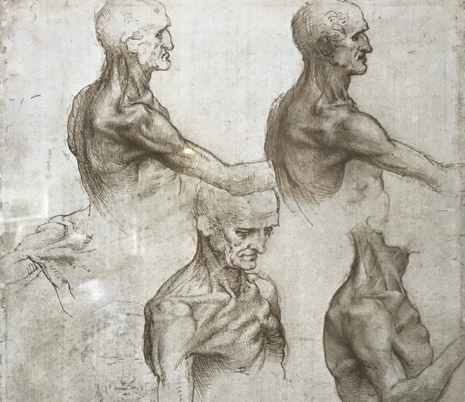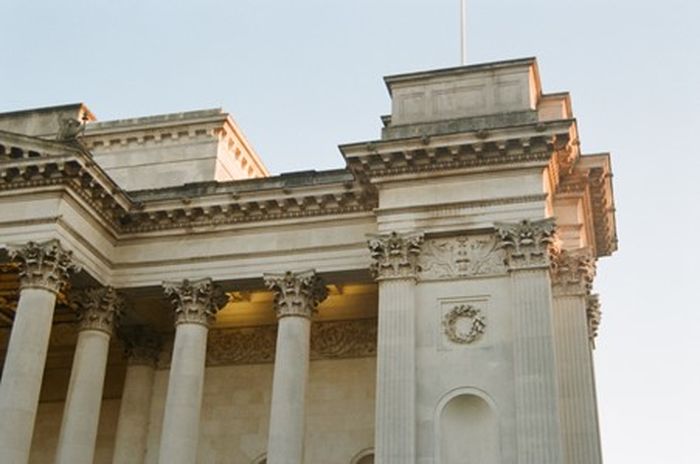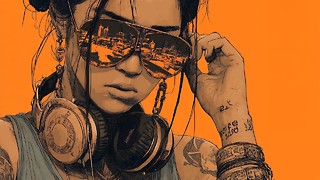The Art and Heart of Leonardo da Vinci
Laila Hussey marvels at works from the great master being shown for the first time in the UK

My experience of the opening night of Clare Hall’s newest exhibition entitled The Art and Heart of Leonardo was a humbling one. And not just for me, I’m sure, but for the dozens of other guests invited to wonder at what hung from the walls. Displayed in a rather informal setting – the open-plan mezzanine level of the porters’ lodge – the genius of Leonardo da Vinci holds strong conviction over the space and reminds all viewers just why he deserves such praise. The exhibition presents a small but awe-inspiring collection of his anatomical sketches which depict various parts of the human form in minute and precise detail. In one, the yellowed page is dominated by his sketch of a calf and pointed foot, flayed to reveal the collection of tendons and ligaments that lie beneath the surface.
“Da Vinci was metaphorically crawling through the dirt to discover the workings of nature”
Crucially, the co-curator of this exhibition: an honorary fellow of the college and esteemed heart surgeon, Francis Wells, has provided illuminating analyses to be read alongside each sketch. They help the viewer contextualise da Vinci’s findings and speculations, as well as offering a translation of the furious notations he made around the sketches in old Tuscan in his attempts to understand why the body is composed in the way that it is – and what it does with what it has.
His curiosity with not only form but also function is what Wells wants to highlight most ardently. Da Vinci was not only an anatomist, but also a physiologist: he craved knowledge not just of the body’s constitution, but also the purpose thereof. His avid curiosity and interest in the most intricate details can only be fully appreciated by viewing the sketches on display. They illuminate the mind of a genius, one with a peerless eye and undaunted zeal for the body’s mechanisms and machinations.
While this exhibition displays Leonardo at his most scientific, his artistic talent is also readily evident. The sketches – while just that – are aesthetic feats as much as they are scientific ones. The subtle shading and skilful proportionality gives them a sense of morbid realism that is both captivating and, as Wells describes it, “really uncanny”. An accompanying quote by Da Vinci gives insight into his own confidence: “this, my illustration of the human body,” he writes, “shall be demonstrated to you, not otherwise than if you had a real man before you.” He understood his own alchemical ability to transfer what he saw in the dissected oxen hearts and human parts onto the page and into a blueprint.
“For da Vinci, the importance of looking, of investigating, was paramount”
Da Vinci was unlike the other Renaissance men of his time. He was not a high-minded artist in the Florentine tradition; he was no Botticelli or Raphael, being less concerned with philosophies and more with active investigation of the world. While other artists were lounging in lush chambers with their wealthy patrons, discussing humanism and other philosophical preoccupations of the Renaissance age, Da Vinci was experimenting with the world, metaphorically crawling through the dirt to discover the workings of nature and coax the Earth’s secrets from her. What made him different makes his works so valuable.
But Leonardo’s work does not exist in isolation, and his influence is everywhere. This is how this exhibition is particularly special. Alongside his work is that of the artistic anatomy students from the Academy of Fine Arts in Venice. This offers a parallel that displays continued excellence in this artistic tradition as well reinforcing da Vinci’s didactic influence and ground-breaking discoveries made 500 years prior. The contemporary works act simultaneously as juxtapositions and evolutions. They tie his work to the present, reminding us of his continued relevance and foundational significance for artists and scientists today.
The plural importance and significance of what’s on show is what makes it so crucial to see. For the scientifically minded, Da Vinci’s strides in anatomical research are astonishing, and for those of a more artistic nature, the sketches demonstrate remarkable aesthetic achievement. The combination of sketches, interpretations, direct quotations, and the work from the Academy of Fine Arts in Venice makes the exhibition worth seeing for its contextual consideration that takes Da Vinci out of his traditionally isolated setting of Renaissance Italy. In co-curating, Wells hopes to “generate more than just ocular interest” but also challenge viewers academically – an impression I certainly came away with.
Wells summed up his speech by imparting advice that I’m sure da Vinci would have affirmed in another time: be relentlessly curious. For da Vinci, the importance of looking, of investigating, was paramount. In this spirit, this exhibition, only seen once before in Los Angeles and partly in Venice, is one to experience.
The exhibition is showing at Clare Hall until June 16th.
 News / Trinity exam burglar jailed for 11 months18 July 2025
News / Trinity exam burglar jailed for 11 months18 July 2025 News / Newnham students warned against using ‘secluded or concealed routes’ in evening after student followed16 July 2025
News / Newnham students warned against using ‘secluded or concealed routes’ in evening after student followed16 July 2025 Lifestyle / Seven species of Sidge17 July 2025
Lifestyle / Seven species of Sidge17 July 2025 News / Fenner’s cricket ground suffering ‘dismal decline,’ action group says 17 July 2025
News / Fenner’s cricket ground suffering ‘dismal decline,’ action group says 17 July 2025 Interviews / The Cambridge student hoping to become mayor of Baltimore: Thomas ‘TJ’ Jones16 July 2025
Interviews / The Cambridge student hoping to become mayor of Baltimore: Thomas ‘TJ’ Jones16 July 2025








